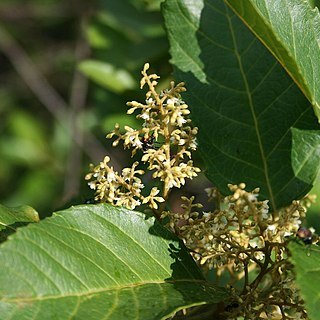Tree or shrub 1.2-24 m. tall; bark rough or smooth, at first red-brown, later grey with prominent lenticels, exuding orange-red resin when slashed; branches densely to sparsely covered with ferruginous hairs or glabrous; young growth with a fugitive scurfy indumentum.. Leaf-blades very variable in size and shape, narrowly elliptic, oblong, lanceolate, ovate, oblanceolate or obovate, 6-22.3 cm. long, 2.1-11.2 cm. wide, obtuse to shortly acuminate or mucronate, cuneate or rounded at the base, subentire or minutely to coarsely and irregularly toothed in upper part, smooth, chartaceous, membranous, occasionally coriaceous, ferruginous-pubescent on nerves above and/or beneath, or sparsely ferruginous-pubescent over lower surface or glabrous, with or without visible gland-dots or streaks; main nerves distinct, midrib often pink, reticulation obscure; petiole±1/6 the length of the leaf-blade, 1.4-4 cm. long.. Inflorescence a much-branched, lax or condensed many-flowered axillary panicle, up to 3/4 the length of the subtending leaf, glabrous to densely ferruginous-pubescent.. Flower hermaphrodite or functionally female, (4-)5-partite; pedicels up to 1 mm. long, glabrous or ferruginous-pubescent, with 2 bracteoles, paired or not, with ciliate margins.. Calyx campanulate; lobes triangular, ovate to broadly ovate,±1 mm. long, with or without darker markings, margins minutely ciliate, occasionally whole surface puberulent.. Corolla white or cream, with or without darker markings, 1.75-3 mm. long,±5 mm. across lobes; lobes spreading, rounded, obtuse,±as long as the tube, glabrous.. Stamens orange, exserted; filaments short, as long as the anthers or less (sometimes aborted but then the flower abnormal); anthers sagittate, not much longer than broad, emarginate.. Ovary adnate to the calyx, glabrous; placenta stalked, globose to ovoid, shortly apiculate; ovules few-many, embedded in the placenta, multiseriate; style exserted, short, stout, cylindrical, up to 1 mm. long; stigma convex, obscurely to distinctly lobed.. Fruit a globose berry, 3-5.5 mm. in diameter, very sweet, irregularly ribbed (in herbarium material), forming pendent clusters, yellowish-brown or red when ripe, with persistent calyx and style, glabrous, many-seeded but few reaching maturity.. Seed small, 2-3.25 mm. long; surface tessellated with many irregularly-shaped pits.. Fig. 1/9-13.
More
Leaves 6–17 cm. long, varying from lanceolate (length 3 times breadth) to broadly elliptic (length twice breadth or less); apex acute to acuminate, base cuneate; petiole 1·5–3 cm. long; margin very shallowly to distinctly serrate, sometimes (in some narrow–leaved specimens) slightly revolute; lamina glabrous or pubescent with coarse, stiff hairs especially on nerves; midrib and lateral nerves conspicuous or inconspicuous when dry.
A shrub or small tree. It has many branches. It grows 6 m tall. The leaves are narrowly oval and alternate. The leaves are large and 25 cm long by 12 cm wide. The flowers are white. They are in dense clusters in the axils of leaves. There are 2 subspecies. The fruit are cream coloured when ripe and are 6 mm across. See Maesa nuda
Flowers pale yellow or whitish, scented, hermaphrodite, pentamerous, borne in axillary panicles usually shorter than leaves; panicle branches usually rufous–pubescent; pedicels 1–2 mm. long, subtended by a subulate bract c. 0·6 mm. long; bracteoles 2, c. 1 mm. long, ovate, opposite, inserted at base of flower.
Corolla 1·5–1·8 mm. long, campanulate, the lobes ± equalling tube, orbicular, imbricate, undulate–margined, with glandular dots or lines.
Ovary semi–inferior, shallowly conical at apex, with fleshy style c. 0·6 mm. long; stigma truncate, somewhat lobed.
Stamens inserted in the corolla tube; anthers 0·4–0·7 mm. long, broadly oblong; filaments very short.
Fruit 3–4 mm. in diameter, globose, crowned with the persistent calyx lobes, greenish to pale pink.
Calyx 1–1·6 mm. long, the lobes 0·8–1·2 mm. long, triangular to ovate, glabrous or ciliate.
Bark rough, grey or reddish–brown, the twigs often with rather prominent lenticels.
Seeds numerous, blackish, angular, granular, embedded in the placenta.
An evergreen shrub or small, much–branched tree 2–10 m. high.
A shrub or small tree up to 20 ft. high


